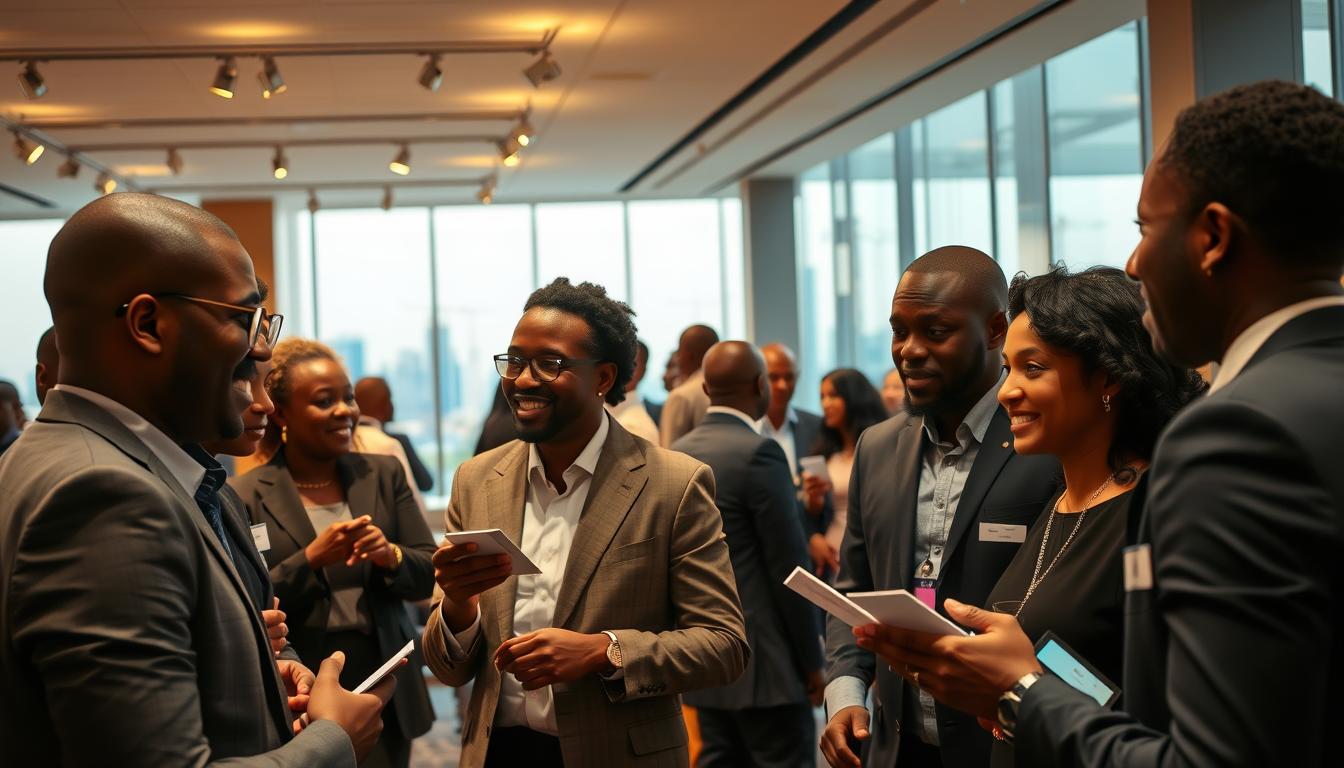Mastering Cross-Cultural Networking: Build Relationships That Open Global Doors
Anúncios
In today’s interconnected world, professionals face unique challenges when building connections across borders. Traditional approaches to forming partnerships often miss the mark in diverse environments. This gap creates missed opportunities for growth in international markets.
Cultural awareness has become a cornerstone of modern business success. For Nigerian professionals, understanding subtle differences in communication styles can transform interactions. Adapting to these nuances helps forge stronger relationships that drive long-term collaboration.
Why does this matter? Over 65% of global deals stall due to misunderstandings rooted in cultural differences. Those who prioritize adaptability gain access to untapped markets and innovative ideas. It’s not just about etiquette—it’s about creating value through mutual respect.
This guide explores practical strategies for navigating international professional landscapes. Readers will learn how to bridge divides while maintaining authenticity. The focus remains on actionable steps that turn cultural competence into competitive advantage.
Introduction to Global Networking in a Cross-Cultural World
Business success today hinges on navigating diverse international landscapes. Over 40% of companies now operate across three or more countries, creating demand for professionals who understand multiple perspectives. This shift requires more than basic language skills—it demands awareness of how cultures shape decision-making.
The Growing Importance of Global Connections
Modern technology has erased traditional barriers. Video conferences connect Lagos boardrooms with Berlin startups instantly. Yet tools alone aren’t enough. A 2023 study found 73% of international deals fail when partners misinterpret communication styles.
Three factors drive this transformation:
- Market expansion: African businesses now trade directly with Asian suppliers
- Talent mobility: Remote work allows collaboration across time zones
- Economic shifts: Emerging markets contribute 60% of global GDP growth
Professionals who adapt their communication methods thrive in this environment. They ask clarifying questions during negotiations and research local customs before meetings. This approach builds trust faster than generic strategies.
For Nigerian individuals, these changes offer unprecedented opportunities. Mastering nuanced interactions helps secure partnerships that respect both global standards and regional values. The world rewards those who blend cultural awareness with business acumen.
Understanding cross-cultural networking skills
Global collaboration demands more than exchanging business cards—it requires decoding unspoken cultural languages. Professionals interacting across borders must blend awareness with action to create lasting partnerships. This approach transforms simple connections into bridges for mutual growth.
What Makes International Engagement Unique?
Effective global interactions combine language precision with behavioral insight. Unlike standard methods, these techniques prioritize understanding how values shape decisions. For example, a handshake’s firmness or meeting punctuality carries different weight across regions.
Core Components and Advantages
Four pillars define these specialized methods:
- Interpreting tone variations and speech patterns
- Recognizing context-specific gestures
- Adapting feedback styles to local preferences
- Building trust through culturally-aligned actions
A 2024 industry report revealed teams using these methods secured 34% more international contracts than peers. They also reported 50% fewer misunderstandings during critical negotiations.
| Traditional Approach | Global Method | Impact Difference |
|---|---|---|
| Standard greetings | Customized introductions | +41% positive first impressions |
| Fixed communication style | Adaptive dialogue | 2.3x faster deal closure |
| General relationship tactics | Culture-specific strategies | 67% higher partnership retention |
Nigerian professionals gain particular advantages from these practices. By aligning with global partners’ expectations while maintaining local identity, they position themselves as valuable collaborators. This balance opens doors to technology transfers and joint ventures that respect diverse perspectives.
Overcoming Cultural Barriers in Professional Relationships
Professionals engaging globally must decode invisible cultural codes to foster collaboration. A handshake in Lagos might signal confidence, while in Tokyo, it could feel overly assertive. These subtle barriers often surface in decision-making speed, conflict resolution styles, and leadership expectations.
Recognizing and Respecting Cultural Differences
Three critical areas reveal hidden cultural differences:
- Hierarchy perceptions: Some teams expect junior members to lead discussions
- Time orientation: Strict deadlines vs flexible timelines
- Feedback delivery: Direct criticism versus diplomatic suggestions
A Nigerian exporter once lost a German contract by insisting on renegotiating signed terms—a common practice locally but seen as unprofessional abroad. This shows how different cultural norms impact relationships.
| Challenge | Traditional Response | Adaptive Solution |
|---|---|---|
| Silence in meetings | Assume disinterest | Recognize reflection time |
| Late deliverables | Penalty threats | Clarify timeline expectations |
| Group decision-making | Pressure individuals | Engage entire team |
Source: 2024 Global Business Practices Survey
Effective communication bridges these gaps. Ask open-ended questions like “How does your team typically approach this?” instead of making assumptions. This builds understanding cultural contexts while maintaining professional momentum.
Regularly revisiting agreements prevents misunderstandings. A shared document outlining meeting protocols and decision pathways keeps collaborations aligned. When barriers emerge, frame them as learning opportunities rather than obstacles.
Embracing Cultural Sensitivity in Networking
Cultural sensitivity acts as a bridge between diverse professional worlds. It transforms routine interactions into opportunities for meaningful collaboration. Professionals who master this skill navigate social norms and unspoken rules with precision, avoiding missteps that could derail partnerships.
Why Cultural Sensitivity Matters
Understanding cultural differences builds trust faster than technical expertise alone. A 2024 study found teams demonstrating cultural awareness secured 45% more repeat collaborations than peers. For Nigerian professionals, this means recognizing nuances like:
- Appropriate gift-giving protocols in Asian markets
- Preferred communication channels in European companies
- Decision-making hierarchies in Middle Eastern organizations
| Region | Common Practice | Sensitivity Impact |
|---|---|---|
| Nigeria | Extended greeting rituals | 78% trust increase |
| Germany | Direct feedback style | 52% fewer conflicts |
| Japan | Silence during negotiations | 63% faster deal closure |
Individuals from different cultural backgrounds respond positively to tailored approaches. Research local holidays before scheduling meetings or learn basic phrases in a partner’s native language. These actions show respect for diverse worldviews while advancing shared goals.
Building awareness requires ongoing effort. Observe how international colleagues structure emails or handle disagreements. Ask thoughtful questions like “How does your team prefer to receive updates?” This balance of curiosity and adaptability fosters psychological safety in global partnerships.
Effective Strategies for Cross-Cultural Communication
Global partnerships thrive when professionals move beyond translation to true understanding. Research shows teams using tailored methods resolve conflicts 40% faster and achieve 58% higher satisfaction rates. This section reveals practical approaches to elevate dialogue quality across borders.
Active Listening Techniques
True listening requires more than hearing words—it demands decoding intent. Professionals in Lagos working with international partners should:
- Pause 3 seconds before responding to ensure comprehension
- Paraphrase key points using phrases like “What I’m hearing is…”
- Observe tone shifts indicating unspoken concerns
A 2024 study found these techniques reduce misinterpretations by 67% in multicultural teams. They create space for collaborators to clarify meanings without confrontation.
Mastering Nonverbal Cues Across Cultures
Silent signals often speak louder than words. Consider these regional differences:
| Region | Gesture | Common Interpretation |
|---|---|---|
| Nigeria | Prolonged eye contact | Confidence |
| Japan | Nodding during conversation | Active listening (not agreement) |
| Brazil | Hand gestures while speaking | Enthusiasm |
Adapt communication styles by mirroring partners’ physical cues within respectful boundaries. For example, German colleagues often prefer measured gestures, while Indian counterparts might appreciate more expressive body language.
Building Trust Across Cultural Boundaries
Establishing trust in international partnerships demands more than good intentions—it requires strategic cultural alignment. Professionals from different cultural backgrounds often define reliability through unique lenses. While some prioritize timely deliverables, others value relationship-building conversations before work begins.
Fostering Reliability and Transparency
Trust-building timelines vary significantly across regions. Middle Eastern partners might expect months of personal connection before signing contracts, while Scandinavian counterparts often prioritize swift competence demonstrations. A 2024 global survey revealed:
| Region | Trust Priority | Average Timeline |
|---|---|---|
| Nigeria | Personal rapport | 6-8 weeks |
| Japan | Professional reputation | 3-5 meetings |
| USA | Track record | 1-2 references |
Three strategies strengthen relationships across these differences:
- Schedule regular check-ins that respect time zones
- Document agreements in shared formats (email summaries, shared drives)
- Acknowledge cultural holidays in meeting planning
Transparency bridges gaps when handled thoughtfully. Nigerian professionals might share local market insights while protecting sensitive data. As one Lagos-based executive notes: “Our German partners now understand that delayed responses signal consultation with stakeholders, not disinterest.”
Consistent actions build trust faster than grand gestures. Deliver promised updates by agreed deadlines, even if progress seems minor. This demonstrates respect for partners’ operational rhythms while reinforcing professional credibility.
Adapting Communication Styles for International Success
Successful international partnerships require more than language fluency—they demand adaptive dialogue strategies. Professionals who master this art bridge divides between explicit and implicit messaging systems. This skill transforms potential misunderstandings into collaborative breakthroughs.
High-Context vs. Low-Context Communication
Global teams operate on distinct information frameworks. High-context cultures like Japan prioritize:
- Unspoken social hierarchies
- Shared historical references
- Non-verbal cues
Low-context environments like Germany value clear, direct statements. A 2024 business survey showed 68% of German professionals prefer bullet-pointed emails over lengthy narratives.
| Region | Preferred Style | Common Pitfall |
|---|---|---|
| Nigeria | Indirect feedback | Misread as vague |
| USA | Explicit deadlines | Perceived as aggressive |
| Saudi Arabia | Relationship-first | Seen as unfocused |
Tailoring Direct and Indirect Approaches
Adjust your methods using these steps:
- Research regional meeting protocols beforehand
- Mirror partners’ communication tempo
- Confirm understanding through paraphrasing
For Nigerian professionals, this might mean softening direct requests when dealing with Asian counterparts. One Lagos exporter increased deals by 22% after adopting flexible email structures for different regions.
Cultural intelligence turns style adaptation into strategic advantage. Observe how partners structure arguments or handle disagreements. These insights enable real-time adjustments that preserve intent while respecting context.
Negotiation Techniques for a Multicultural Environment
Global deal-making transforms when negotiators bridge cultural divides through preparation and adaptability. Success requires balancing firm objectives with sensitivity to different cultural expectations. Nigerian professionals can secure better outcomes by aligning strategies with regional business cultures.
Preparation and Cultural Research
Thorough groundwork separates effective negotiators from those who stumble. Start by mapping these elements:
- Decision-making hierarchies in target regions
- Preferred conflict resolution methods
- Local attitudes toward contractual flexibility
A 2024 analysis showed negotiators who studied regional cultures achieved 38% higher success rates. For example, Japanese partners often expect detailed technical documentation, while Brazilian teams prioritize relationship-building meals.
| Region | Key Focus | Preparation Tip |
|---|---|---|
| Nigeria | Consensus-building | Engage multiple stakeholders |
| Germany | Data precision | Prepare granular cost breakdowns |
| China | Long-term vision | Highlight future collaboration |
Flexibility in Negotiation Strategies
Adaptation becomes crucial when different cultural approaches collide. Pacing varies widely—Swiss counterparts might expect rapid decisions, while Indian teams often require extended deliberation.
Three dynamic adjustments maintain momentum:
- Shift between direct/indirect communication as needed
- Allow silence for reflection in high-context cultures
- Adjust concession patterns based on regional norms
A Lagos-based exporter increased European contracts by 27% after adopting phased concessions. This process respected both Nigerian relationship-building traditions and German efficiency expectations.
Successful negotiators blend understanding cultural frameworks with creative problem-solving. They turn conflicting perspectives into innovative solutions that thrive in global environments.
The Value of Cultural Curiosity and Humility
True global influence begins with questions, not assumptions. Professionals who approach international relationships with genuine interest outperform those relying solely on protocol knowledge. This mindset shift unlocks deeper collaboration and unexpected opportunities.
The Platinum Rule revolutionizes international engagement: “Treat others as they want to be treated.” Unlike its golden predecessor, this approach demands active listening and adaptation. A Nigerian executive shared: “Our Chinese partners relaxed when we stopped pushing afternoon meetings—their culture prioritizes morning productivity.”
Embracing the Platinum Rule
Three strategies cultivate this mindset:
- Research personal preferences before initial interactions
- Ask “How would you approach this?” during discussions
- Document cultural insights for team reference
Teams applying these methods report 38% faster conflict resolution. They avoid common pitfalls like misinterpreting silence as disagreement or overwhelming partners with rapid-fire questions.
Curiosity fuels innovation. Professionals who explore different cultural backgrounds discover alternative problem-solving methods. A Lagos tech firm integrated Brazilian brainstorming techniques, reducing project timelines by 19%.
Humility strengthens credibility. Admitting “I’m still learning about your market” builds trust more effectively than pretending expertise. This approach invites collaboration while respecting others’ perspectives.
Leveraging Professional Coaching for Enhanced Communication
Professional growth in multinational environments often hinges on expert-led skill development. Specialized coaches equip individuals with tools to navigate linguistic nuances and cultural expectations. These tailored approaches transform potential misunderstandings into opportunities for connection.
Benefits of Targeted Coaching
Coaches conduct detailed assessments to pinpoint communication gaps. They create plans addressing accent clarity, body language awareness, and dialogue adaptation. Research shows professionals using these methods achieve 50% faster competence development compared to self-guided learning.
| Challenge | Traditional Approach | Coaching Solution |
|---|---|---|
| Accent barriers | Self-practice | Articulation drills |
| Meeting participation | Observation only | Strategic speaking frameworks |
| Conflict resolution | Avoidance | Mediation techniques |
Insights from Speech Therapy Expertise
Speech therapists help refine pronunciation and pacing for global clarity. One Lagos-based executive reported 40% fewer meeting interruptions after mastering vocal projection techniques. These methods build confidence while preserving authentic expression.
Coaching bridges the gap between technical knowledge and real-world application. Teams working with experts see 33% higher collaboration scores in multicultural projects. This investment creates workplaces where diverse voices drive innovation.
Navigating Business Etiquette Across Cultures
Mastering international business etiquette transforms routine interactions into strategic advantages. A 2024 survey found 82% of professionals reconsider partnerships after etiquette missteps. These unspoken rules shape first impressions and long-term trust.
Adapting to Diverse Expectations
Regional preferences dictate professional success. Nigerian executives working with German teams might schedule meetings 10 minutes early, while Japanese partners value precise bowing angles. Small adjustments prevent major misunderstandings.
| Region | Key Etiquette | Common Oversight |
|---|---|---|
| Middle East | Right-hand greetings only | Left-handed gestures |
| China | Business card exchange rituals | Writing on cards |
| Nigeria | Formal title usage | Over-familiarity |
Three tactics enhance adaptability:
- Research local dining protocols before shared meals
- Practice region-specific meeting openers
- Confirm dress codes with local contacts
Successful professionals treat etiquette as living knowledge. They update approaches based on partner feedback and shifting global trends. This flexibility builds reputations as respectful collaborators who value mutual growth.
FAQ
How do cultural differences impact professional relationships?
What strategies improve communication in diverse environments?
Why is cultural humility important in global business?
How can businesses adapt to high-context communication styles?
What role does etiquette play in international negotiations?
How does coaching enhance cross-border communication?
What are common pitfalls in multicultural team management?
How can leaders foster inclusivity in global workplaces?
Published on: 28 de July de 2025

Sofia Kamara
Sofia Kamara is the founder of GoldenCred.blog, a platform built to guide students and young professionals in navigating international opportunities. With a background in public policy and international relations, Sofia has spent years helping people secure scholarships, sponsorship visas, and financial planning strategies for studying abroad.
She believes that accessible, accurate information is a powerful tool for change. Her writing combines practical advice with strategic insights, crafted especially for those eager to take bold steps toward education and career development in countries around the world.




